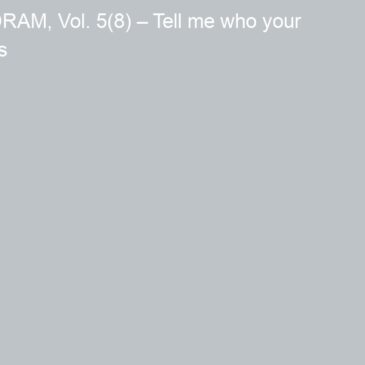Some people suggest that you can tell a lot about people by the company that they keep. It is unclear, however, whether behavioral similarities of friends and partners are due to influence (people becoming like their friends or partners) or selection (people gravitating toward similar friends or partners). Addressing this issue, this week’s The DRAM reviews a study that examines the associations between adolescent alcohol use and adolescents’ perception of their partners’ alcohol use (van der Zwaluw et al., 2009).
Method
Participants and procedure:
- Investigators interviewed parents and adolescents from 428 Dutch families once a year for four years (T1-T4). Each family consisted of two parents and two siblings. The retention rate was 81% across the study.
- Both siblings participated. The mean age was 13.4 years for the younger siblings and 15.2 years for older siblings.
- Only participants who reported romantic involvement at a given time point were used in these analyses (e.g., 36% of older siblings and 26% of younger siblings at T4).
Main measures:
- Participants self-reported: (1) their frequency of alcohol use during the past 4 weeks; (2) whether they currently were in a steady romantic relationship; and (3) their estimation of their partner’s frequency of alcohol use during the past 4 weeks.
Results
- According to participants’ estimation of their own and their partner’s alcohol use frequency, participants and romantic partners were relatively similar in their alcohol use (r = .42, p <. 01).
- Partners’ alcohol use (as estimated by participants) did not significantly predict later participant alcohol use if prior participant alcohol use was taken into account (see Figure, first row).
- However, adolescents tended to select partners with similar drinking habits: participants’ use of alcohol at a given time point predicted their partner’s alcohol use one year later (see Figure, second row).
|
|
T1→T2 (N) |
T2→T3 (N) |
T3→ T4(N) |
|
PartneràParticipant1 |
0.09 (149) |
0.18† (181) |
−0.02 (241) |
|
ParticipantàPartner2 |
0.17 (149) |
0.25** (181) |
0.26** (241) |
Figure. Prospective relations between partner and participant alcohol use frequency (adapted from van der Zwaluw et al., 2009). Click image to enlarge.
Notes: 1 The numbers in this row reflect the correlation between the partner’s alcohol use and the participant’s alcohol use one year later, controlling for the prior levels of participant’s alcohol use. † p < 0.10; 2 The numbers in this row reflect the correlation between the participant’s alcohol use and the partner’s alcohol use one year later. ** p < .01
Limitations
- Self-reported results (both for own and partner’s alcohol consumption)
- Specific sample (adolescents who start dating early)
Conclusion
Adolescents and their romantic partners are similar in how much alcohol they consume. Results from this study suggest that this similarity is best explained by the initial selection of a partner rather than by the influence of partners’ drinking habits on adolescents. The lack of correlation between a partner’s alcohol consumption and the adolescent’s alcohol consumption one year later might be explained, as the authors suggest, by the fact that most adolescent relationships are short-lived. Together, these findings suggest that research and intervention efforts addressing peer influence on drinking behaviors in adolescence ought to focus on peer groups, not romantic partners.
— Julia Braverman
What do you think? Please use the comment link below to provide feedback on this article.
References
van der Zwaluw, C. S., Scholte, R. H. J., Vermulst, A. A., Buitelaar, J., Verkes, R. J., & Engels, R. C. M. E. (2009). The crown of love: Intimate relations and alcohol use in adolescence. European Child & Adolescent Psychiatry, 18(7), 407-417.




